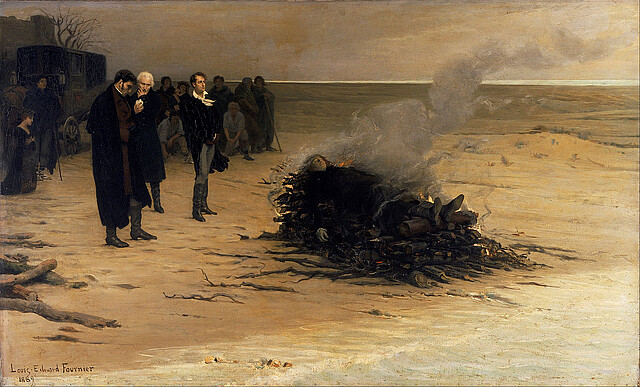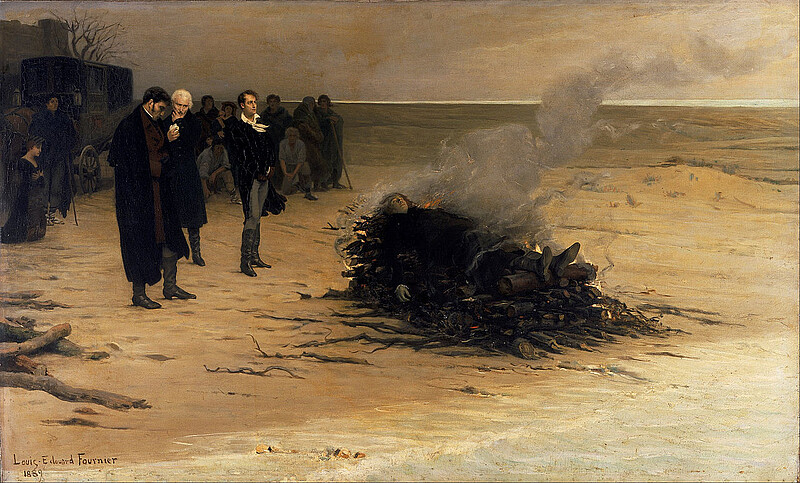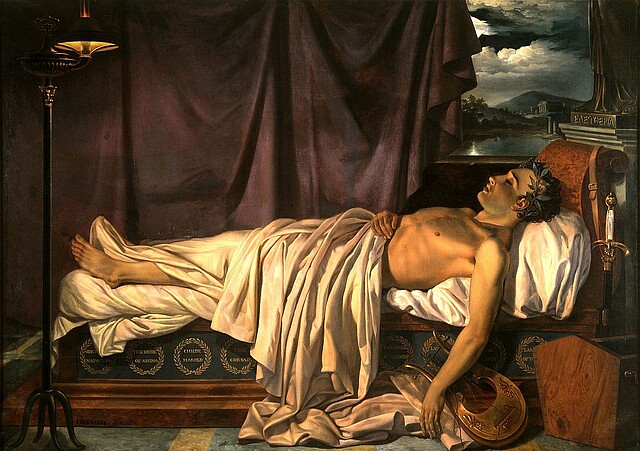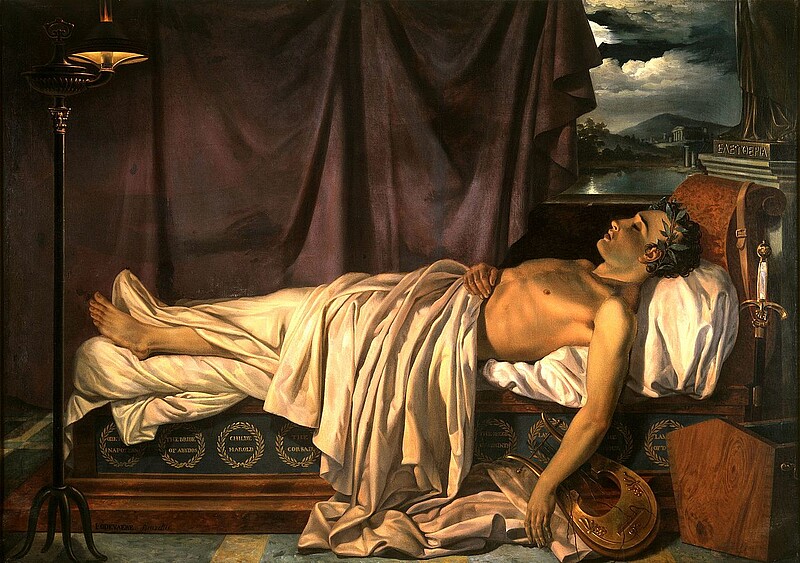Lord Byron’s Many Masks
A.A.: As someone who is currently based at the University of Jena in Germany, I of course also have to ask about this: You mention that, while Byron was visiting Germaine de Staël and her circle in 1816, he also met with August Wilhelm Schlegel. Is there anything more known about this meeting, except that it took place?
A.S.: Not much, unfortunately. Byron’s relationship to the Germans is thin, as far as we know. Unlike Coleridge and other Romantics, he seems to not have been interested in Idealism and also didn’t have German as a language. It’s probable that he saw German Romantic Idealism as something that was not really relevant to what he was doing. Then again, Goethe was huge … Byron was very interested in him; he wrote to Goethe. It’s clear that Faust made an impression on him, and Byron in turn to seeped into the groundwater of German literature pretty early. He became important for the generation that followed.
A.A.: One key difference between Byron and the German Romantics also seems to be that, while there was a lot of enthusiasm for the French Revolution in Germany at first, that shifted into fervent anti-French sentiment when Napoleon Bonaparte invaded Germany in 1806. By contrast, Byron was a lifelong defender of Napoleon?
A.S.: I think that was partly a way of rebelling against his own countrymen, whom Byron had always seen himself in battle with. He saw himself as a Napoleonic figure; championing Napoleon was a way of investing in a provocative stance of liberty against what he would call tyranny and monarchy and all of that … Of course, Byron was a Lord himself, so he’s this complex figure.
A.A.: Speaking of “complications”: Something I keep thinking about, and something that your book argues against very effectively – by juxtaposing, among other things, Byron’s voice and your biographical writing on him, highlighting all of the inconsistencies, the personal as well as political contradictions contained therein – is a kind of reification that has occurred with Byron as a popular figure. Once I started thinking seriously about Byron and his afterlives, I realized how often not only Byronic heroes keep showing up in the literature of the past two centuries from Brontë to the Twilight-saga, but also how often Byron himself is imagined as a literary character, be it in absentia in Tom Stoppard’s Arcadia, be it in Nabokov, in Susannah Clarke’s Jonathan Strange & Mr. Norrell, Jeanette Winterson’s Frankissstein. In most of these, however, Byron seems to be condensed purely to the epithet of “mad, bad and dangerous to know” that [his erstwhile lover, A.A.] Caroline Lamb said about him.
A.S.: Yes, it’s a real problem: “Mad, bad and dangerous to know” is a quote that we would almost wish would go away, because it tends to do a lot of simplification. It’s partly a celebrity effect – Byron is arguably one of the first modern celebrities, a creature of media whose personality and work are inextricably involved and who, over time, becomes a kind of cartoon version of himself in the public eye –, and he of course contributes to that the way all celebrities do. He tends to be reduced to certain facts of his biography, which are then confused with things his Byronic heroes do, but my goal in the biography was really to draw out the complexity of this human. The Byronic hero was just one of many masks that he wore, and this simplification partly points to a lack of reading the poetry itself. We tend not to read Byron. We tend to feel like we already know him because we know the character so well – that character had such a penetration in the western culture! We get a few anecdotes like “oh, he had all this sex, or he did this, or that,” but those are just brief anecdotes that don’t at all point to the complexity of the man.
A.A.: What also comes to the fore repeatedly throughout your biography and breaks with this notion of Byron as a Byronic hero are two embodied aspects: On the one hand, you talk a lot about the physical struggles that Byron was grappling with, for instance his lifelong fight struggle with eating disorder, his very conflicted self-image, his lameness, and also the sexual abuse that he suffered as a child. On the other, of course, there’s the matter of sexual violence that he might have been a perpetrator of.
A.S.: Right: There are dark secrets hidden in the past of the Byronic hero in his classical form, and he is capable of violence. We see that in everything from Mr. Rochester [from Charlotte Brontë’s 1847 Jane Eyre, A.A.] to Heathcliff [from Emily Brontë’s 1847 Wuthering Heights, A.A.] to Edward Cullen in Twilight: There is a violence that is barely suppressed, and that is part of the energy, of the thrill. But Byron as a man is complicated. His body is the site of many problems, shall we say, and many contradictions – that handsome face that everyone praised, and then the deformed leg. There was the physical courage of a man who could travel as much and do as many things as he did, but then also indolence and a kind of lethargy or lassitude. And there was his complex sexual behavior with men, women, young people – we are not sure how young … So I tried to make him an embodied person and less of a myth, someone whose body was often doing things that he wasn’t capable of stopping. The eating disorder can be seen as an attempt to control the body, to starve it down because it tended to corpulence, and whatever was going on in his brain might in itself have had organic origins related to early childhood trauma. He also seems to have had seizures, fits, various mental eruptions … I am not a doctor, but they strike me as having a possibly organic basis. Even his brain, his genius, was frequently betrayed by that.
A.A.: Which is of course precisely what creates so many contemporary access points and connects Byron to matters of acute interest in the 21st century …
A.S.: That’s right! And it’s hard to see those clearly in his own time. His bisexuality is a good example: What do we really know about it when so much had to be kept secret back then? We know he did have a sexual life with both men and with women, but how did he think about that, how did his peers think about that, and to what extent it was a struggle for him, to what extent it was part of the rainbow of bodily experiences he had in his life? We need to strike a balance: To what extent, when we use words like “neurodivergent” or “polyamorous,” words of our time, do they let us see Byron more clearly, and to what extent do they just warp him into the creature we want him to be? All we can do is get back to the writing itself, get back to the words: You can start there, and then you need a lot of context to answer the question “okay, what really was going on here?”
A.A.: Would you say that there has been a particular affinity between Byron and later types of genre literature? It sees that especially the fantasy genre is one of these places where Byronic heroes proliferate, and of which Byron himself could be posited as a predecessor: He does write plays about magicians, poems with apocalyptic and borderline-vampiric imagery …
A.S.: Yes, his poetry is involved with that reputation, but the longer reception of it goes more through the Byronic heroes. It’s a game of telephone: You think of Heathcliff and all the influences Heathcliff has on the fantasy-romance drama, same as Mr. Rochester … Moreover, the vampire began in that summer of 1816 at Lake Geneva. There, Polidori [Byron’s personal physician, A.A.] wrote The Vampyre, which was the first vampire story where the monster was a handsome gentleman rather than a ghoulish grave-crawler. In a sense, that whole modern vampire-thing developed out of Byron. Class is related to it, too: Americans love aristocrats, even as we claim to hate them! There is a kind of nostalgia, particularly in the fantasy or romance genre, that we want aristocrats in one way or another. Maybe they eventually get rejected for the farm boy, but ultimately there’s that American Dream to both be an egalitarian nation and still have the trappings and titles of aristocracy. Lord Byron allows for that to happen, and it works with the vampires as well.
A.A.: My second-to-last question is just for personal curiosity: In your book, you mention that – despite what legends claim – it might not actually have been Percy Shelley’s heart that did not burn when he was cremated on a beach near Lerici [a seaside town in Liguria, A.A.], but his liver. Is that a probable thesis?
A.S.: There seems to be a lot of debate about these poets’ internal organs! I was just in Missolonghi [Greece, A.A.] where Byron died, and half the people claim “it’s his lungs that are buried here” – “no, it’s his heart that was buried here!” It’s almost too perfect. After all, it was Trelawny [the poet Edward John, A.A.] who supervised Shelley’s burning, who lit the fire, and who put his hand in and claimed it was the heart that he took out. Trelawney is a well-known liar, or, you know, exaggerator – let’s say romanticizer …
A.A.: The heart does sound so much more poetic than the liver.
A.S.: I mean, how do you even know? It was a piece of flesh at that point, a speck of a fire, but it makes poetic sense. There actually was a squabble about who got to hold on to this relic. Eventually, Lee Hunt was persuaded to give it to Mary Shelley, and she kept it in her writing desk for many years. It effectively was his heart, his relic. Funnily enough, the inscription on Shelley’s grave in Rome reads “cors cordium” [“heart of hearts,” A.A.,] so Shelley’s heart is one of those words to conjure with. And that’s another lost object: We don’t have that thing, whatever it was, that piece of leather or piece of flesh. We don’t know what has occurred to it, but maybe, like Byron’s memoir [which was burnt by his friends after his death, A.A.], we’ll find it one day …
A.A.: How magnificent: All of these storytelling affordances, in addition to the research details! That brings me to my last point: If there is one particular thing you would like readers to take from your book, one new thing they should realize about Byron, what would that be?
A.S.: I think it relates to what we’ve been talking about: the complexity of this person beyond the caricature of “mad, bad and dangerous to know,” the many different sides of this personality, many of which are relevant to our own time … Readers should come away from it with less a sense of Byron as a cartoon or a character but a richer sense of what we mean when we say the word “Byronic.” Also, I’d love readers to come away and say “I want to read the poetry! This was the tasting menu, but I really want to get into the verse that made him so famous and that held the attention of centuries of readers. What is this stuff?”
Conducted via Zoom in Jena (Germany) and Charlottesville (Virginia, USA) on July 11, 2024
The interview has been shortened and edited for clarity.



